AMD's A10-5750M Review, Part 2: The MSI GX60 Gaming Notebook
by Dustin Sklavos on June 29, 2013 12:00 PM ESTDisplay Quality
High dpi displays, even if they're TN panels, tend to perform fairly well, and the 1080p 15.6" panel on the MSI GX60 is at least a healthy one. I feel like at long last we're finally starting to come out of the dark ages of 1366x768 panels; virtually none of the notebooks I've tested recently have had bad or low-resolution panels. With tablets pushing pixel density ever higher and TN panels only showing up on the cheapest of the cheap, the notebook industry has been running out of excuses to fob crappy displays on us. You'll still see them at the lowest and most mainstream price points, but the trickle-down mercifully seems to have begun.
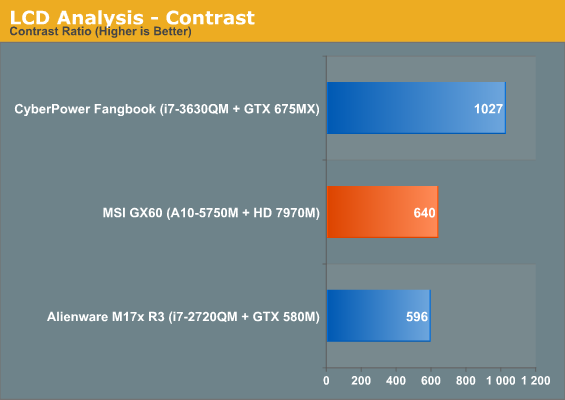
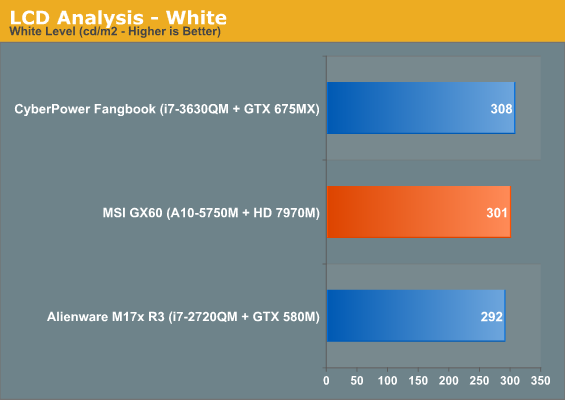
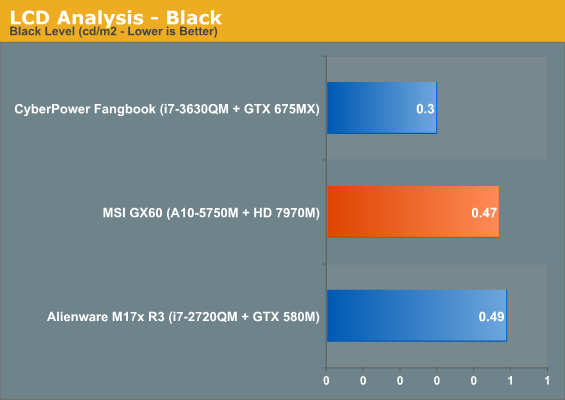
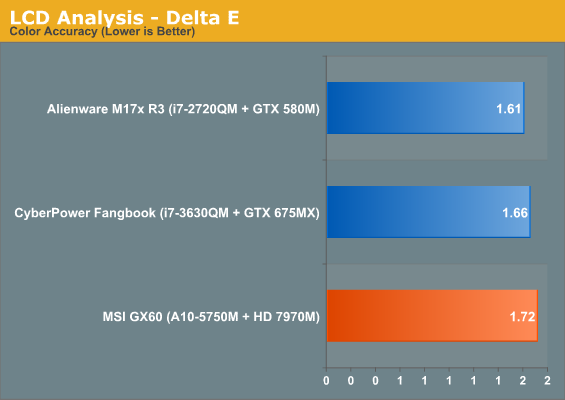
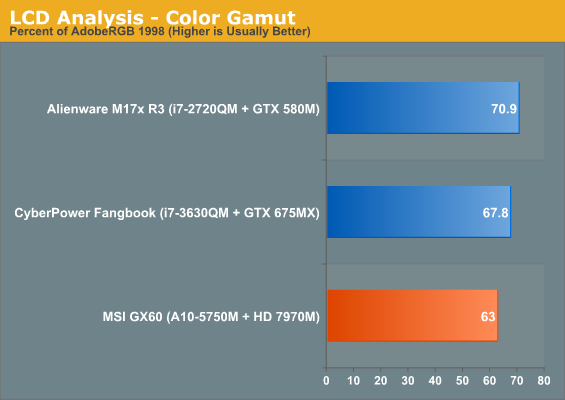

The panel MSI uses for the GX60 isn't exemplary, but the contrast ratio is a far cry from the sub-300 or even occasional sub-200 TN panels of the entry level market. If nothing else, the 1080p display is more than adequate for both gaming and any basic work, and I appreciate that MSI has stuck with the trend in the gaming notebook market of moving towards matte panels. Alienware was the last holdout, but their refreshed line of notebooks doesn't feature glossy displays either.
Battery Life
Unfortunately, perhaps frustratingly, we weren't able to get battery running time results for the original Trinity-based GX60, so MSI's new Richland-based model is stuck in the wilderness. Jarred has also reported continued issues with AMD's Enduro technology, but my experience with it on the GX60 was actually pretty painless. Enduro's interface is still miles behind NVIDIA's Optimus, but I at least have hope now that AMD will be able to compete and level the playing field. As it stands, NVIDIA hardware has been ubiquitous in the notebook space. While that's good for them, consumers need choice and competition.

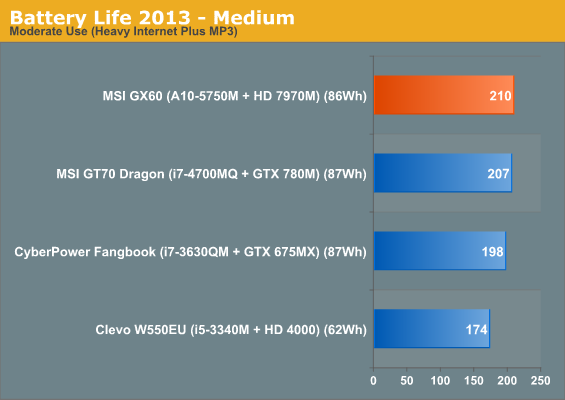
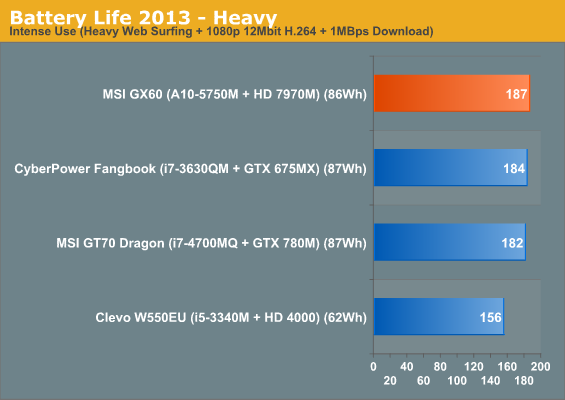
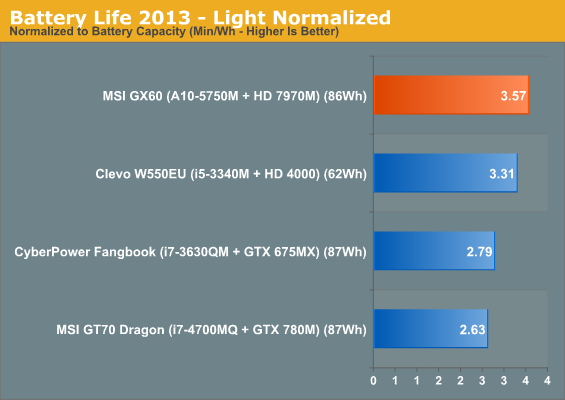
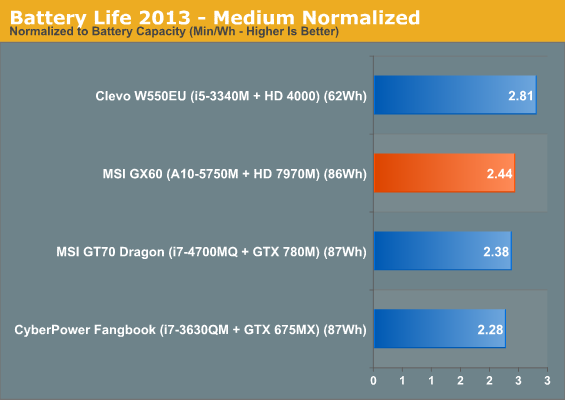
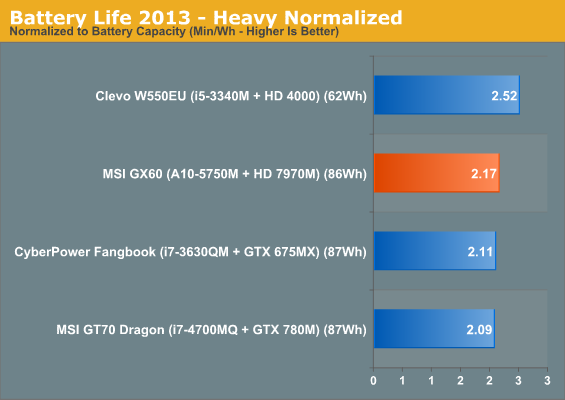
Compared to the other gaming notebooks tested and even the lone Clevo ultrabook, the MSI GX60 is able to actually produce pretty excellent battery life. If all you're doing is casually surfing the internet, the Richland-based APU powering the GX60 can give you a solid five hours of running time.
Heat
While the larger GT70 Dragon Edition had trouble managing its thermals (hopefully fixed with a BIOS update, more on this to come soon), the GX60's dealing with a much lower thermal load. The Intel Core i7-4700MQ coupled with the GeForce GTX 780M results in a peak power draw of almost 150W between the CPU and GPU, while the GX60 tops out at 110W.

I'm not sure what HWMonitor is reading as the "package" temperature, but I can tell you that's not what the APU is running at. For a better idea of how hot the system is running, take a look at the "THRM" value and the temperature value under the Radeon. The GX60 has no trouble dissipating the heat from the A10-5750M and Radeon HD 7970M.










69 Comments
View All Comments
JarredWalton - Sunday, June 30, 2013 - link
My testing suggests otherwise. Despite having 20 EUs vs. 16 EUs, HD 4400 and HD 4600 are generally about the same performance as HD 4000. I've even got a quad-core standard voltage i7-4700MQ system (MSI GE40), and surprisingly there are several games where the HD 4600 iGPU fails to be a significant upgrade to an ULV HD 4000 in and i5-3317U. I'm not sure if Intel somehow changed each EU so that the Haswell EUs are less powerful relative to IVB, but outside of driver optimizations (it's still early in the game for Haswell) I have no good reason for the lack of performance I'm getting from HD 4600.sheh - Monday, July 1, 2013 - link
The i7-4500U review showed not much of a difference at times, and even slightly lower performance, but +20% in other cases. i7-4770 vs i7-3770 shows more improvement. I'm guessing the improvement in a 37W CPU would be more like the desktop parts rather than the 15W CPU. But, well, all theoretical anyway.TheinsanegamerN - Saturday, June 29, 2013 - link
its a little problematic, i think. they are ultrabook cpus, and bga to boot. it's cheaper to make laptops with rpga connectors than soldering the cpu to the motherboard. until rpga models appear (not likely) we might not see that many. they are also $100 more expensive than ultrabook models from last year, so a lot of maufacturers are still using ivy. toshiba just brought out 3 new laptops, two are ultrabooks, all which use ivy instead of haswell.TheinsanegamerN - Saturday, June 29, 2013 - link
never mind, just found list that included socketed models. guess the oems are just slowIntelUser2000 - Saturday, June 29, 2013 - link
The SV dual cores are actually Q4, so its quite a few bit left. They are planning on phasing it out in favor of U chips, where it Broadwell it disappears entirely.sheh - Sunday, June 30, 2013 - link
On the forum you said Q4 is rumors, any more concrete info since then?arthur449 - Saturday, June 29, 2013 - link
I wouldn't sell or buy a laptop if it didn't have all its available memory channels populated. This entire review is pointless to me.JarredWalton - Saturday, June 29, 2013 - link
Because buying an extra 8GB DIMM for $75 or whatever is too hard? And it will only help with iGPU performance?arthur449 - Saturday, June 29, 2013 - link
Mainstream CPUs have used a dual channel memory controllers for so long that simply disabling access to one channel can have (as we've seen in this case) a not insignificant effect on benchmarks that do not directly stress the GPU portion of the chip. CPUs have had uses for more memory bandwidth before there were on-chip GPUs, afterall.Furthermore, in scientific terms, due to the author changing two variables in this experiment (var1a: iGPU. var 1b: dual channel. var2a: dGPU. var2b: single channel.) to compare the iGPU to the dGPU, we cannot be certain that the subtraction of the second channel of memory has a non-zero effect on dGPU performance.
If the author's intention was merely reviewing the out-of-the-box performance of this hardware configuration of the MSI GX60 Gaming Notebook, this would be fine. Instead, the article is titled: "AMD's A10-5750M Review: ..."
I'm not trying to be unnecessarily harsh. And the subject of this review could very easily apply to my interest. (I *just* purchased a laptop for a family member with an AMD A8-5550M.) But if the author is going to test the processor's gaming performance: don't change more than one variable.
TheinsanegamerN - Saturday, June 29, 2013 - link
the single channel ram should be fine in this case, since its not used for video at all. at least its 1600mhz